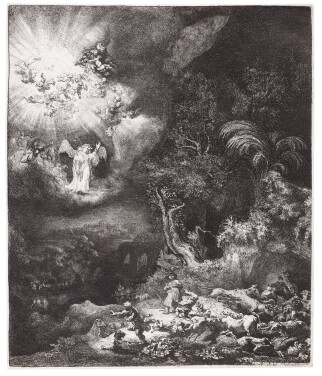S otheby’s is delighted to present our inaugural Old Master Prints sale this November in London. Led by two distinguished single-owner collections – the Collection of the Late Walter L. Strauss and an Important Private American Collection – the sale comprises several of most sought-after graphic subjects by Albrecht Dürer, Hendrick Goltzius and Rembrandt Harmensz. van Rijn. These coveted works are complemented in the auction by a selection of rare early German woodcuts and intricate Kleinmeister engravings, as well as scarce prints by Daniel and Hieronymus Hopfer, Lucas Cranach the Elder, Anthony van Dyck and Martin Schongauer.
Featured Highlights
Albrecht Dürer’s Striking Moment of Divine Intervention

Sotheby’s November Old Master Prints sale comprises a fascinating group of prints from the collection of the esteemed art historian and publisher, Walter L. Strauss. A Nuremburg-born immigrant to the United States, Strauss ran a toy importation company in New York in the years following World War II. Though this was a full-time responsibility, the entrepreneur’s voracious mind compelled him to begin studying at night, and his attention turned to the great Renaissance artist with whom he shared a birthplace: Albrecht Dürer.
In 1970, Strauss established a publishing house in New York, Abaris Books. Abaris published a multitude of art historical and philosophical texts, the most significant of which was The Illustrated Bartsch, an immense and now indispensable compendium of Old Master prints.
Strauss himself wrote and edited many important titles, including The Woodcuts and Wood Blocks of Albrecht Dürer (1979) and the six-volume catalogue, The Complete Drawings of Albrecht Dürer (1974). His purview then extended to the works of another illustrious figure in art history: Strauss later edited Hendrick Goltzius, 1558-1617: The Complete Engravings and Woodcuts (1977), and Hendrick Goltzius, Master Engraver 1558-1617 (1980).
Given his steadfast dedication to the scholarship surrounding Dürer and Goltzius, along with other epoch-making Old Masters such as Rembrandt, it is an honour for Sotheby’s to present such an important group of works by the printmakers whom Strauss so diligently collected and researched. The collection comprises several of these great artists’ most celebrated prints, such as Dürer’s Four Horsemen of the Apocalypse, Goltzius’s The Large Hercules, and Rembrandt’s Self-Portrait in a Cap, wide-eyed and open-mouthed.

Social life in Early Modern Italy was marked by fierce competition and rivalry. While noble families jockeyed for position and turf wars raged, artists in the Italian states were embroiled in a battle of their own: disegno vs. colorito. The school in favour of disegno argued that mastering design, or draughtsmanship, was crucial, while the opposition emphasized colour application as the most essential skill.
The region's early appreciation for disegno and esteem for invention, or invenzione, on paper paved the way for a booming print industry. Models for Western print publishing and distribution were established in 16th-century Rome, while artists from as far as the Low Countries flocked to Florence, Venice, Bologna, and their environs to study with master engravers and vie for coveted positions as court printmakers. For visiting artists who were limited to devotional and religious imagery in their native lands, the Italian taste for ornamental works, mythology, and extravagant portraiture opened new doors. Altogether, the selection of Italian and Italianate subjects in this sale celebrates the dawn of a new era for the fine art print.

This auction includes four of Dürer's most revered prints, subjects that are also considered to be incontestable masterworks of Renaissance printmaking: St Eustace, Melencolia I, St Jerome in His Study, and The Four Horsemen of the Apocalypse.
Melencolia I and St Jerome in His Study form two of Dürer’s Meisterstiche (the 'master prints’), an informal trilogy of engravings that are astonishing in both their technical and iconographic complexity. In these prints dating to 1514, both of which depict lone figures in richly detailed and highly symbolic environments, one witnesses the pinnacle of Dürer's skill in the medium of engraving. Similarly, The Four Horsemen of the Apocalypse – a dynamic and hugely powerful image – is still considered to be an unsurpassed feat in the medium of the woodcut.
St Eustace, Dürer’s largest engraving, is also one of his most coveted. Since its execution in 1501, the work has been held up as an exemplar of Dürer's virtuosity as a printmaker. At the same time, the composition – and in particular its animals in their shifting poses and the landscape in its breathtaking detail – was canonised by ensuing generations of artists for whom it served as a model.
Moreover, these examples of Dürer's most momentous subjects are all fine and early impressions, scrupulously put together through the discerning vision of a learned and passionate collector. They have since remained, for some decades, in the same private collection.

Occasionally today’s print collectors are fortunate enough to find an unusual treasure that offers a rare glimpse into the Early Modern imagination. This sale presents a selection of such rarities and oddities, which survey ingenuity and humour from the fifteenth to seventeenth centuries. Rare metal cuts and early German woodcuts finished by hand shed light on the experimental approach to printmaking in the North, while elaborate gameboards and abstract amalgamations of grotesque animal heads demonstrate the role of the print in entertainment.
Such curiosities came to be as Humanist thought swept Europe, allowing emerging and established printmakers the increased freedom to explore their own interests, from mythology and mysticism to everyday life. Armed with gouges, burins, and eventually etching needles, they rendered these wild and wonderful images, exerting great effort on even the most diminutive details. Their didactic and decorative prints reward close looking and continue to amuse a broad audience while promoting their artistic prowess.






































